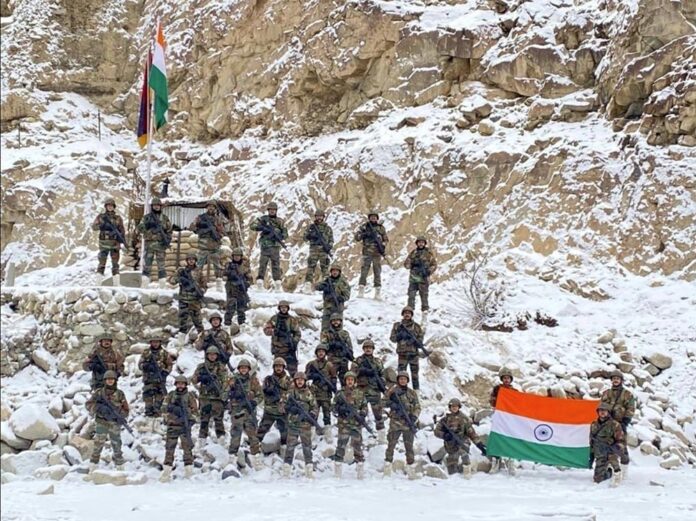
(TibetanReview.net, Jan05’22) – To debunk what was stated to be China’s false propaganda claim that it had unfurled its Red Flag on the Galwan Valley in India’s border Union Territory of Ladakh on the New Year Day, India showed its own soldiers holding its national tricolours there on the same day. The valley was the site of a deadly non-fire arms clash in the night of Jun 15, 2020, leading to casualties on both the sides and the build-up of forces to the current warlike standoff.
China’s state media had earlier put out a video that went viral on its social media, showing its People’s Liberation Army (PLA) soldiers unfurling their national flag supposedly in Ladakh’s Galwan Valley to celebrate the ushering in of the New Year 2022. The video was initially shared by the official Global Times newspaper on Chinese social media platform Weibo at 11:35 am Beijing time on Jan 1.
Sources in the Indian security establishment said the site of the Chinese soldiers celebrating the New Year was in a depth area on the occupied Tibet side near the Galwan Valley region and that it was not at all close to the buffer zone created in the region after the series of disengagement talks held in the aftermath of the Jun 2020 Galwan Valley clashes, reported thehindu.com Jan 4.
The PLA has used the exact location in the past for similar types of symbolic ceremonies, noted theprint.in Jan 3.
And on Jun 4, the Indian Army released two pictures which showed that its troops were fully in control of its side of the valley, holding the Tiranga (the tri-coloured Indian national flag) in snow-capped Galwan Valley on Jan 1.
While the Indian Army soldiers could be seen holding the Tricolour in snow-capped Galwan Valley, the Chinese soldiers were not in an area that had snow on the ground or peaks when they unfurled their flag, noted the timesnownews.com Jun 4.
The Chinese video had the caption: “China’s national flag rises over Galwan Valley on the New Year Day of 2022.” And to enhance the propaganda rhetoric, the video further said the flag was “special since it once flew over Tiananmen Square in Beijing”.
The eastern Ladakh border standoff between the Indian and Chinese militaries erupted on May 5, 2020, following a violent clash in the Pangong lake areas. Both sides gradually enhanced their deployment by rushing in tens of thousands of soldiers as well as heavy weaponry.
After a series of military and diplomatic talks, the two sides completed the disengagement process last year in the north and south banks of the Pangong lake and in the Gogra area.
However, an impasse remains on complete disengagement. Disengagement at Depsang and Hot Springs remains a key sticky point. There is still a huge build-up of forces on each side of eastern Ladakh even during the harsh winter, with each side having around 50,000 to 60,000 troops along the Line of Actual Control (LAC) in the sensitive sector, noted thehindu.com report and the ndtv.com Jan 4.
However, the New Year day also saw Indian and Chinese troops exchanging sweets and greetings at 10 border points along the Line of Actual Control (LAC) including in eastern Ladakh and North Sikkim, noted thehindu.com report. It was seen as a warm gesture in the midst of the lingering row in eastern Ladakh.
The 13th round of Corps Commander-level military talks in Oct 2021 ended in a stalemate with the Indian Army saying that the “constructive suggestions” made by it were not agreeable to the Chinese side.
In their virtual diplomatic talks on Nov 18, India and China agreed to hold the 14th round of military talks at an early date to achieve the objective of complete disengagement in remaining friction points in eastern Ladakh.





